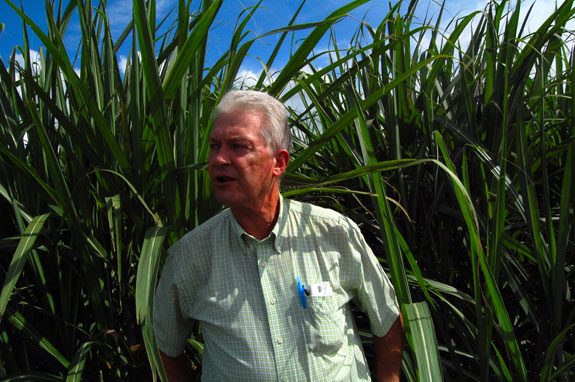
Rick Roth, who grows sugar in Belle Glade, believes demand would prevent the U.S. price of sugar from plunging if the government removed price supports. (Photo by Amy Green.)
Listen to the companion radio report from partner WMFE Public Broadcasting:
By Amy Green
Florida Center for Investigative Reporting
BELLE GLADE, Fla. — Behind every candy bar and can of soda is a complex government program of import tariffs and farmer loans establishing the price of sugar. The program, which has been in place in one form or another since shortly after the founding of the United States, is responsible for the success of Florida’s $1.3 billion sugar industry, the nation’s largest producer of sugar cane.
About This StoryThis story is a result of a collaboration between the Florida Center for Investigative Reporting and WMFE Public Broadcasting in Orlando. Media partners include The Ledger in Lakeland, the Center for Public Integrity in Washington, D.C., and the Center for Investigative Reporting in Berkeley, Calif. Links to partner stories will be posted as they become available. Center for Investigative Reporting RelatedSlideshow: Big Sugar in the Everglades Agricultural Area En Español |
That success, according to government and independent studies, comes at a cost to consumers every time they shop at grocery stores. The studies, including a report by the Government Accountability Office, conclude the sugar program inflates the U.S. price of sugar, costing consumers about $2 billion annually in increased food prices.
Despite its adverse impact, the sugar program survives on the political largesse of sugar growers, who are among the most generous in the agribusiness industry. This election cycle, sugar growers spent $3.6 million in campaign contributions, outpacing the tobacco industry’s $2.8 million. Big Sugar is as big as ever, spending millions to preserve a price support program that inflates the cost of groceries including bread, fruit juice and ketchup.
The sugar program is part of the Agriculture Reform, Food and Jobs Act, or the Farm Bill, which shapes U.S. policy on agriculture, rural development, environmental conservation, food aid and more. The Farm Bill comes up for renewal every five years, and is set to expire this year on Sept. 30. Several high-ranking politicians are now trying to put an end to the program. At stake for Florida is a sugar industry responsible for 33,000 jobs.
Republican presidential candidate Mitt Romney is among the sugar program’s critics. “We ought to get rid of subsidies and let markets work properly,” Romney said in January.
Without the program, Florida’s sugar industry would compete with growers worldwide who enjoy government support of their own and whose surpluses are dumped below cost on the world market, said Phillip Hayes, a spokesman for the American Sugar Alliance, which represents Florida’s growers.
Although sugar growers say the program should not be considered a subsidy, since it does not involve direct payments to farmers, lawmakers have introduced multiple measures intended to reform or end the program. A measure ending the program introduced last year by Sen. Richard Lugar, an Indiana Republican and a member of the Senate Agriculture Committee, garnered support from the U.S. Chamber of Commerce, Kraft Foods, Sweetener Users Association, National Association of Manufacturers, Everglades Trust and Americans for Tax Reform, an organization led by lobbyist and activist Grover Norquist, known for persuading 1,100 politicians nationwide to sign a no-new-taxes pledge. But Lugar’s bill, later revised to reform the sugar program rather than end it, failed along with others.
Both of Florida’s senators, Democrat Bill Nelson and Republican Marco Rubio, voted against ending the program. Nelson, whose re-election campaign against Rep. Connie Mack is considered among the races that will determine control of the Senate, is the Senate’s second-largest beneficiary of sugar growers this election cycle, having received $42,000 in contributions. The greatest recipient is Sen. Debbie Stabenow, a Michigan Democrat and chair of the Senate Agricultural Committee. Stabenow, who has received $49,986 in contributions, also voted against ending the sugar program. Rubio, a Republican who was vetted as a possible vice presidential candidate with Romney and who writes in a recently published autobiography about the support he received from sugar growers during his 2010 campaign, collected $5,000 from Big Sugar.
The Senate passed its version of the Farm Bill in June, protecting the sugar program. But now that the Farm Bill is in the Republican-controlled House, the sugar program may face more opposition.
Sugar politics
Florida produces 2 million tons of sugar cane annually, constituting half of the nation’s domestic supply of sugar cane. The industry is situated in the Everglades Agricultural Area, a 700,000-acre swath of fertile land south of Lake Okeechobee including parts of Glades, Hendry, Martin and Palm Beach counties. The area represents 27 percent of what used to be the Everglades. The area is so compact, and so remote, that many Floridians have never seen a sugar cane field.

Keria Smith, 20, lives in a two-bedroom, one-bathroom Belle Glade house with her mother, her mother’s boyfriend and her 3-year-old sister. In Belle Glade and neighboring Pahokee, the U.S. Census Bureau estimates unemployment and poverty rates at 45 percent. (Photo by Amy Green.)
Here the world’s largest sugar cane mill, owned by U.S. Sugar Corp., grinds 42,000 tons daily, providing up to 10 percent of the nation’s domestic sugar supply. During the crop season from October through April, harvesting and processing continue 24 hours a day. U.S. Sugar is the nation’s largest producer of sugar cane, owning an independent short-line railroad, the South Central Florida Express, connecting fields with mainline railroads. Approximately 36 percent of the nation’s sugar comes from cane, 44 percent from sugar beets and the rest from imports. Sugar cane grows in Florida, Louisiana, Texas and Hawaii, while sugar beet is farmed in 11 states extending from the Great Plains to the West.
Politics and the sugar industry long have been linked, and in the narrative of U.S. politics, Big Sugar has played a supporting role at the highest levels. In 1996, for example, President Bill Clinton and intern Monica Lewinsky were in the Oval Office, in the middle of a conversation about their relationship, when the phone rang. The intern would later tell Independent Counsel Kenneth Starr the call was from a Florida sugar grower whose name she remembered as “Fanuli.” Lewinsky was referring to Alfonso Fanjul, who with his brother Jose owns Florida Crystals Corp., a company that traces its roots to pre-communist Cuba. Including its subsidiaries, Florida Crystals is the world’s largest sugar refiner, with an annual production capacity exceeding 7 million tons and operations in Florida, California, Louisiana, Maryland, New York, Canada, Mexico, England and Portugal. That Clinton accepted a call in the Oval Office from a Fanjul brother during a meeting with someone who would partly define his presidency illustrates how much influence Big Sugar has in Washington, D.C.
The Fanjul brothers have maintained their influence through the years. Today, the Fanjuls, nicknamed Alfy and Pepe, are known for their wealth and political connections. Marco Rubio, a Cuban-American and tea party-backed politician who rails against government overreach, wrote about the Fanjuls in his autobiography, An American Son, and described their role in his 2010 Senate campaign.
“The end of August saw a slight uptick in our fundraising,” Rubio wrote. “We were collecting more envelopes at my speeches. Some of our midsized events were raising as much as $20,000. The mail was starting to make money. The crown jewel of the quarter would be the fundraiser in New York in late September, hosted by the Fanjul family, a Cuban American family that owns a large sugar and real estate conglomerate. It sounded unbelievable, but if the event hit its target, we stood a good chance of posting a million-dollar quarter.”
One reason for Big Sugar’s political influence is its willingness to pool resources among competitors with common interests to keep the U.S. sugar program in tact. For example, U.S. Sugar’s competitor-turned-ally is American Crystal Sugar Co., the nation’s largest producer of sugar beets with factories in the upper-Midwest. American Crystal Sugar is Big Sugar’s biggest spender this election cycle and also the biggest spender in the agribusiness sector, a powerful special interest whose political spending outpaces the defense industry. American Crystal Sugar has spent $1.6 million this election cycle, followed by $1.2 million from Altria Group (formerly Philip Morris Companies), $577,000 from Weaver Popcorn Co. and $571,000 from the Fanjuls’ Florida Crystals. U.S. Sugar has spent $166,300.
Together American Crystal Sugar, U.S. Sugar and North Dakota-based Minn-Dak Farmers Cooperative own Minnesota-based United Sugars Corp., which the companies describe as a marketing cooperative. The partnership reveals collaboration between the nation’s largest producer of sugar cane, U.S. Sugar, and the nation’s largest producer of sugar beets, American Crystal Sugar, making U.S. Sugar the country’s first nationwide producer and distributor of refined sugar. It also places the Florida company’s product in congressional districts nationwide.
American Crystal Sugar’s spending has ballooned from $300,000 to $600,000 in the early 2000s to $2 million in recent election cycles. So far this year, American Crystal Sugar has spent $1 million on federal lobbying. American Crystal Sugar also maintains a political action committee, which has collected $2.6 million this election cycle.

President Barack Obama has received $22,700 from Big Sugar, while Sen. Bill Nelson has taken in $42,000 from the industry. (Photo by Bill Ingalls/NASA.)
Florida lawmakers are among the principal beneficiaries of Big Sugar. In addition to Sen. Nelson, the largest benefactors this election cycle include Florida Senate President Mike Haridopolos ($39,940), who last year dropped out of the Republican race for Nelson’s seat; Rep. Tom Rooney ($31,250), a Republican whose district includes the region where sugar cane is grown; Connie Mack ($29,000), the Republican candidate for the U.S. Senate whose father held the seat from 1989 to 2001; and Rep. Debbie Wasserman Schultz ($24,500), chair of the Democratic National Committee. Big Sugar tends to favor Democrats, who are more receptive to government programs, but the spending reveals an effort to curry bipartisan favor. President Barack Obama has received $22,700 from Big Sugar, for example, while his Republican challenger this year, Romney, has received $22,500.
Big Sugar’s Florida PlayersU.S. Sugar Corp. is the nation’s largest producer of sugar cane. The company, based in Clewiston, shares a marketing partnership with Minnesota-based American Crystal Sugar Co., the nation’s largest producer of sugar beets. The partnership makes U.S. Sugar the country’s first nationwide producer and distributor of refined sugar. Florida Crystals Corp. is the world’s largest sugar refiner, with a production capacity exceeding 7 million tons annually and operations in Florida, California, Louisiana, Maryland, New York, Canada, Mexico, England and Portugal. Based in West Palm Beach and owned by brothers Alfonso and Jose Fanjul, Florida Crystals describes itself as a family-built company with roots tracing back to pre-communist Cuba. The Sugar Cane Growers Cooperative of Florida harvests and mills sugar cane for its 46 owners, who all share in the cooperative’s revenue. Together the Sugar Cane Growers Cooperative and the Fanjuls’ Florida Crystals own New York-based American Sugar Refining Inc., which as a Florida Crystals subsidiary bills itself as the world’s largest sugar cane refiner with a production capacity of 7 million tons. |
For Florida, the sugar program makes growing sugar cane possible, according to Lance deHaven-Smith, a professor of public administration at Florida State University who studies state politics and history.
“It’s called a collective action problem. The people who have a stake in it see their interest, and they are all over it. They are constantly working on it,” deHaven-Smith said. “But the other side, the people who are paying a little more for their cereal in the morning, they never see it, and so they never mobilize. That’s the problem.”
The sugar program guarantees growers a minimum price by controlling supply and limiting imports through tariffs. When the supply is high and the price low, the program goes further, allowing for loans that farmers can satisfy by forfeiting their crops to the government. Since the 1970s, as a result of the price supports, the U.S. price of sugar has been nearly double the world price most years. This price difference represents the program’s most significant cost to food consumers, according to Michael Wohlgenant, a North Carolina State University agricultural economics professor who has studied the U.S. sugar program.
A report Wohlgenant authored estimates the program costs food consumers $2.4 billion per year and provides sugar producers with $1.4 billion per year in benefits. Other studies support Wohlgenant’s findings. A 2000 report from the Government Accountability Office, the most recent available, found the program cost domestic sugar and sweetener users $1.9 billion in 1998. A 2006 U.S. Department of Commerce report found higher domestic sugar prices were a major factor in the loss of more than 10,000 jobs between 1997 and 2002 at manufacturers using sugar in their products. The report estimates nearly three confectionery manufacturing jobs are lost for every sugar-growing job saved through the sugar program.
The inflated U.S. price of sugar has also contributed to widespread use of high-fructose corn syrup as a lower-cost alternative, although in recent years the price of high-fructose corn syrup has risen with demand for corn ethanol while the price of sugar has held mostly steady. Meanwhile, by limiting imports into the United States, the sugar program has depressed the world price of sugar by about 8.5 percent, Wohlgenant found, affecting the bottom lines of some of the world’s poorest farmers.
Wohlgenant believes the world price of sugar today is high enough to sustain the current U.S. price, making the U.S. sugar program needless. “I think everybody would agree with this: If the program were done away with, the price would fall some from what it is in the United States, but it won’t fall below that price support,” Wohlgenant said.
Precedent exists for ending the sugar program. In 1974, when commodity prices boomed because of an energy crisis, inflation and global commodity shortages, lawmakers suspended the sugar price support. Wohlgenant estimated that if U.S. sugar were to compete on the global market without government supports, the world price of sugar would rise 8.5 percent, but the U.S. price would tumble 41.5 percent — a boon for food consumers but a bust for farmers in the economically depressed Everglades Agricultural Area.
“Given the present state of the economy in that area, any drop in sugar prices would be devastating,” said Phil Bacon, vice president of neighborhood and regional initiatives at the Collins Center for Public Policy, a nonpartisan think tank. “If people can understand what U.S. Steel used to mean to Pittsburgh, when the steel mills closed down and so forth, they can understand what it would mean to this area. This area needs to diversify its economy, but as of now, because of the fact that the sugar business has had some price supports and done fairly well for the last year, year and a half to two years, it still makes a lot of sense for that region to be defined by sugar.”
Sugar state
Belle Glade is one of a half-dozen communities in the Everglades Agricultural Area, where millions of perfectly aligned rows of sugar cane extend to the horizon in all directions, green and swaying.

Butch Wilson, a 32-year U.S. Sugar Corp. employee who was laid off in 2007 and now serves as curator and director of the Clewiston Museum, said ending sugar price supports would devastate the Everglades Agricultural Area. (Photo by Amy Green.)
“This is the most significant single area for growing food in the United States,” said Rick Roth, president of Roth Farms, sitting in his modest Belle Glade office. “California as a state grows a lot more food, but they grow it over a 400-mile area. We’re talking about farming in one area almost year-round. Nobody else does that.”
Roth Farms is a mid-sized sugar and vegetable farm raising several thousand acres of sugar cane, radishes, lettuce, sweet corn, green beans and rice. Roth’s father established the farm in 1948 after moving to Florida with his family from Ohio, but he didn’t begin growing sugar cane until 1962. Today, Roth estimates two-thirds of his farm’s production is cane.
Roth’s father was a founding member of the Sugar Cane Growers Cooperative of Florida, which harvests and mills sugar cane for the cooperative’s 46 owners. Roth has served on the board of the cooperative since 1994. Together the Sugar Cane Growers Cooperative and the Fanjuls’ Florida Crystals own New York-based American Sugar Refining, which as a Florida Crystals subsidiary bills itself as the world’s largest sugar cane refiner with a production capacity of 7 million tons. The Sugar Cane Growers Cooperative also contributes to Big Sugar’s political spending. The cooperative has given $51,750 this election cycle in political contributions.
Roth engages in politics, giving his money to candidates and his time to the Farm Bureau of Florida as an unpaid activist, because he said politics are a “contact sport.”
“One of the biggest crimes is people complaining about politics, but they never get involved,” he said.
Farming is a risky business dependent on weather and global markets, Roth said, and the sugar program helps growers mitigate that risk.
“What the sugar program does for me as a farmer, it gives me a stable plan I can go to a banker with and say, ‘Look, I’m producing this many acres of vegetables and this many of sugar cane,'” he said. “‘Will you loan me $2 million to plant my crops?’ And they go, ‘Yeah.’ They want the estimates: What are the costs, and what are you going to sell the sugar for? And having a sugar program means the banker knows with certainty I’m not going to sell the sugar below this price. He knows I’m going to get at least 18 cents, and he knows I’m going to sell all of my sugar …
“I can’t sell farm land and get completely out this year and then 10 years from now go, ‘Gee, the price of sugar cane went up. I’ve got to get back in the business,’ ” Roth continued. “That land is now more expensive. I can’t get in and get out. That’s not what we want. What we want is some type of safety net so that farmers keep farming.”
Research for this story was funded in part by United Arts of Central Florida.
